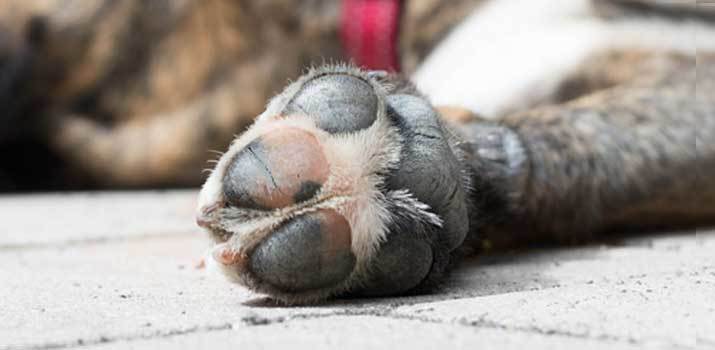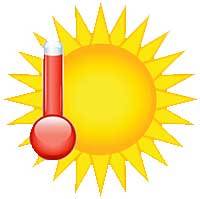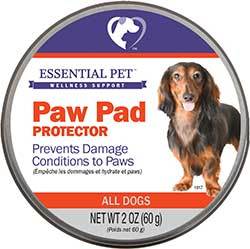When we walk outside, we have socks and shoes to keep our feet protected from dirt, bacteria, and rough surfaces. Dogs, on the other hand, aren't so lucky! Most dogs will run outside without a worry in the world about foot protection!
Fortunately, canines have some natural defenses to keep them safe. But what if those defenses aren't enough? Your dog's paws are not immune to issues. While the footpad does a lot to absorb shock and provide some insulation,
Your dog's paws can become dry, brittle, and cracked!

Think of it as having cracked heels or chapped lips. Their paws become sensitive and irritated, making it difficult to walk comfortably. In extreme cases, cracked paws can make way for serious bacterial infections!
So, what exactly causes dry, cracked dog paws? And what can you do to treat it?
8 Common Causes of Damaged Paws
Your dog's paws are like any other part of their body. While they may be tough, the paw pads are a biological feature that responds to changing conditions and environmental factors just the same.
There are many reasons why the paws can become dry and cracked. Here are some of the most common.
#1. Rough Surfaces
Have you ever taken a moment to feel your dog's paw pads? If they're in good shape, they will be smooth to the touch and slightly squishy. The pads are covered in a layer of pigmented skin and are filled with fat to absorb shock.
Unfortunately, the smooth and fatty nature of the pad makes it susceptible to abrasive damage!
Rocky surfaces are notorious for scuffing up the paws. The same goes for heavily wooded areas filled with sharp weeds or sticks. You might see your dog limping or trying to walk around without stepping on anything.
Injuries aren't always apparent right away. But regular exposure to those kinds of environments will weaken the pads. Eventually, they will dry out and start cracking.
#2. Hot Temperatures

If it's too hot for you to walk on the sidewalk without any shoes, it's too hot for your dog.
Hot pavement can burn the paws. As a response to that, your dog will spend all of their downtime licking their feet in an effort to get relief.
This will dry them out and only exacerbate the problem.
#3. Extreme Cold
Like hot temperatures, cool weather can be a dilemma. Snow and ice will damage the pads and cause cracking.
Canines are susceptible to frostbite, so you need to make sure that your dog is fully protected.
Even if they're not walking on ice or snow, cold ambient temperatures can deprive your dog's skin of moisture. This includes the skin on the paw pads.
#4. Chemicals and Surface Irritants
Whether your pup is walking on grass or a sidewalk, they could be stepping on chemicals and surface irritants.
Pesticides, fungicides, and fertilizers can irritate your dog's skin. The same goes for things like salt or sand during the wintertime. In your home, your dog might have exposure to household chemicals, such as the bleach you use to mop your floors or the deodorizers you use on your carpets.
#5. Allergies
Is your dog allergic to certain foods? Curiously enough, food allergies can lead to severe skin irritations on the paws.
At first, the skin will feel itchy and uncomfortable. This forces your dog to start chewing and licking any exposed skin on your body. Before you know it, you're dealing with dry, cracked paws.
Related: 5 Best Hypoallergenic Dog Foods for Dogs with Allergies
#6. Insufficient Nutrients
Nutrients deficiencies can cause some unique side effects in dogs. The mineral zinc, for example, is known to make the paw pads thick and hardened.
If your dog isn't getting enough zinc in their diet, the pads are deprived of moisture. Instead of feeling springy, they may start clicking on the floor as your dog walks!
Without intervention, the pads will dry out so much that they start cracking. All dogs are at risk for zinc deficiency. However, it commonly affects Siberian Huskies, Great Danes, and German Shephards.
#7. Health Concerns
Finally, your dog's dry and cracked paws could be a result of a medical issue. There are a few different offenders to keep an eye out for.
The first is hyperkeratosis. This could be the result of genetics or problems with the immune system. It leads to the overproduction of keratin, which creates fine hair-like filaments to grow on the dog pads. These filaments feel dry and crusty. Over time, they can tear and lead to infection.
Next, there's pemphigus. Pemphigus is an immune disorder that causes blisters to form on the bottom of your dog's paw. Those blisters burst, resulting in a fine layer of crust. The process will repeat and eventually spread to the nose if not addressed.
Finally, there's hard pad disease. Most common in puppies, hard pad disease usually occurs when dogs recover from distemper.
#8. Callouses
Sometimes, your dog's paws are dry because of simple wear and tear. Dogs can form callouses just like humans. Regular hard impacts from vigorous exercise or rough surfaces will create tough points on the skin.
Without moisturizing, the callouses will harden to the point of cracking.
How to Remedy Dry Paws
Once your figure out what's causing your dog's dry paws, you can take the steps to remedy it. If the problem is a product of disease, you'll need to take your pup to the vet. The only way to address those issues is to treat the underlying cause.
For everything else, you can use several techniques to provide relief and improve the condition of your dog's paws.
Examine and Clean the Pad
First things first, you'll need to examine and clean the paw. Even light cracks will open up a can of worms. Bacteria and viruses can easily get into those cuts, leading to worse health problems you don't want to deal with.
Clean and disinfect any cuts with saline solution. For deeper injuries, take your dog to a vet. They may use traditional stitches to close the wound. Or, they could use glue-based stitches to seal the cut and prevent bacterial problems.
Wrap It Up
After you have cleaned the paws, you'll want to wrap it up. Dogs will instinctively lick their wounds.
While it's a valiant effort to promote healing, licking will only make the injury worse in most cases.
Wrapping up the paws keeps it clean and slobber-free. You could also use a cone or donut to create a physical barrier. But, bandage wraps are more comfortable.
Paw Balms

Once any cuts have healed, you can get to work rehydrating your dog's paws!
There are many ways to go about this. The easiest is with a commercial balm. Designed for sledding dogs and active canines, balms will provide a much-needed boost of hydration to stop cracking.
Most balms contain hydrating waxes, beneficial oils, and a host of other ingredients.
Just apply the balm liberally and wrap your dog's paws so that it has time to soak.
Natural Moisturizers
Don't want to buy balm? Chances are, you have some hydrating ingredients you can use around the house. Shea butter and coconut oil are perfect for treating dry paws. The remedies are safe and effective.
Improve Their Diet
Improving your dog's diet can work wonders. Encourage them to drink more water and address any nutrient deficiencies they might be facing.
You can also utilize omega fatty acid supplements. Omega fatty acids can calm inflammation, hydrate the cells, and nourish the skin. Consult with your vet before you make any major changes. They'll be able to help you find a suitable supplement that will benefit your pooch.
Preventing Future Paw Problems
It'll take some time to restore your furry friend's paws. But once you get there, your pooch will be much happier.
Moving forward, you can take the following steps to ensure that their paws stay in good shape.
Regular Grooming
Keeping your dog's paws clean and trim is important. The fur around the toes can harbor moisture and bacteria, which will only irritate the skin and cause dryness.
Trim any hair on the bottom of the paw pad. You don't have to eliminate it completely. Just clean it up to avoid bacterial buildup.
Dog Boots
Dogs boots are an adorable accessory that provides a safe barrier against temperature and irritants. They're basically shoes for your canine companion!
Boots are readily available at most stores. You can get simple disposable boots to protect from water or thicker models to deal with extreme temperatures.
Whatever the case may be, there's a good chance that your dog will need some time to adjust. Let your dog get used to wearing the boots before heading out. Don't forget to provide treats, too!
Conclusion
It's a good idea to check on your dog's paws every once in a while. They could be causing your pup pain without you even knowing it! Dry and cracked paws can open up the floodgates to other health concerns.
Don't ignore them! Address the issue at hand, remedy the situation, and do your best to avoid issues in the future.
Also Read: 6 Remedies to Stop a Beeding Dog’ Nail

